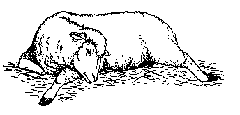

Introduction/Causative Agents:
Pregnancy toxemia, ketosis, or twin lamb disease is a nutritional stress syndrome of pregnant sheep and goats during the last 2-4 weeks of gestation. Occasionally, this problem can also occur during lactation. This problem happens when a ewe’s or does’ system has a shortage of glucose (blood sugar). The animal’s body demands more glucose than can be readily supplied by carbohydrate intake and stores of glycogen in the liver. The body then turns to the formation and release of ketones.The disease is associated with ewes/does carrying a large single fetus, twins, or triplets where a high energy demand is placed on the mother. Anything that causes the ewe or doe to decrease her feed consumption (change in weather, severe heat or cold, stress from transport, or other disease conditions, etc.) will cause a drop in glucose and an increase in ketone production. An animal that is excessively fat will also lack sufficient room in the abdomen for adequate feed intake.
Clinical Signs:
At first, the ewe/doe may be lethargic and try to separate herself from the rest of the flock or herd. As the problem progresses, the ewe/doe may lack coordination and lie with her head turned back. She may circle, bump into objects, quiver and shake, or twist her neck and elevate her face as if "star gazing." Because many of these animals experience some degree of blindness, they are alert and react to sound but are reluctant to move. They may face man or dogs, but make no attempt to escape. The feces are dry, firm, and low in volume. Teeth grinding can be seen and heard. The unusual smell of ketones ("sweet breath") may be present on the breath. Untreated animals experience convulsions and are unable to rise for three (3) to four (4) days before death. Ewes/does near lambing may be weak and have great difficulty in giving birth. Many times the lambs/kids die and remain in the uterus or are born dead. |
 |
Diagnosis:
Pregnancy toxemia should be a consideration with any ewe/doe that is pregnant with multiple fetuses and has the appropriate clinical signs. Low blood sugar (glucose) and increased ketones in the urine and blood are common findings that specifically diagnose a case of pregnancy toxemia. Necropsy of these animals will show a pale, swollen, friable (easily torn or damaged) liver. The dead ewe/doe may have signs of dehydration and have multiple fetuses in the uterus. Because it may look somewhat like pregnancy toxemia, cases of hypocalcemia should also be ruled out.Treatment: Sick ewes/does may temporarily respond when treated with oral glucose (60 mLs of propylene glycol) early on in the disease. In desperate situations when propylene glycol is not available, Karo syrup, any pancake syrup, and especially molasses can be used. These substitutes are fed at the same level as the propylene glycol. The oral products can be given by taking a large syringe and slowly squirting the liquid towards that back of the animal’s mouth. The information about drenching on page C174 can also be utilized. Animals with ketosis may shiver, shake, urinate, defecate, and appear normal after the glucose administration; this may help to establish a diagnosis (glucose response test). However, this one treatment will not solve the negative nutritional balance, and additional treatments are necessary.
An intravenous (IV) dose of 60-100 mLs of 50% dextrose solution should be given. Valuable or very sick animals should also be given a continuous drip of IV fluids that contain 5% dextrose. Lactated ringers and sterile saline solution (with 100 mLs of 50% dextrose solution added to each liter of fluid) are commonly given. Sodium bicarbonate is sometimes added to the lactated ringers or saline solution to help combat acidosis. See IV fluid administration ideas on F145 for additional help. Propylene glycol (30 mLs) administered by mouth 2-3 times a day is also of benefit. The supplemental glucose should be given until the animal begins eating a normal amount of high energy feed.
Continued treatment consists of getting rid of the nutritional drain on the mother caused by the fetus or fetuses. This means performing a cesarian section or inducing labor with steroids or prostaglandin (ewes require 15-25 mg of dexamethasone; while does require 10 mg of prostaglandin F
2a).Prevention:
It is much easier to prevent pregnancy toxemia than it is to treat it. The key to prevention is determining what animals are pregnant with multiple fetuses and when they are due. Ultrasonic pregnancy determination is the most accurate means of identifying these animals. Once animals carrying twins, triplets, etc. are identified, they can be separated and placed on a diet that will meet their increased energy demands.In general, increase the level of nutrition gradually over the last six (6) weeks of gestation. Provide adequate trough space and avoid sudden changes of feed quantity and quality. Provide extra feed in bad weather. If it is determined that pregnancy toxemia could be a problem in the herd or flock, feed whole grains (i.e. corn and barley). These are excellent sources of concentrated energy, particularly if pastures and ranges are in poor condition. In general, feeding 1-2 lbs. of grain per head per day and plenty of quality roughage during the last six (6) weeks of pregnancy can meet the energy needs of most ewes/does carrying multiple fetuses. All animals should be maintained at a body condition score of 2.5-3 throughout gestation. This will prevent any ewes or does from becoming excessively fat.